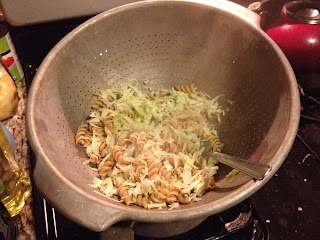The road that led to this, the Perfect Macaroni and Cheese, was a road of stupidity. I've always known how to make exactly this and I've always known it would be amazingly delicious and yet I kept trying other mac and cheese recipes. Instead of using my grandmother 's method I've been looking elsewhere - in cookbooks, on-line - for the "perfect" recipe. Because I'm dumb. So, so, dumb. In fact, the only reason I used my grandmother's method this time is that I had leftover milk from the corn chowder I made on Sunday, and there is only one thing I ever use milk for - making a white sauce. Which I add cheese to. And then put over broccoli or cauliflower. But only rarely, because I don't think you have to throw tons of cheese sauce on a vegetable to make it delicious.
Another note: The thought of certain foods + cheese makes me go "EEEEWW." And cabbage was kind of on that list. (Also on the list: tofu, any meat substitutes, olives, all fruit, nuts, rice.) I was 100% certain, when I started this, that I would hate it. Which did not stop me, which I think is telling. I will never again make macaroni & cheese without a vegetable. It tastes delicious and makes my tummy happy. Perfection. I'm afraid to look at the nutritional value, though.
Here are some key tips:
* Use enough vegetables, and mix them in, so your fork gets both vegetables and pasta. Also, as your intention is to have both vegetables and pasta on your fork, cut your vegetables appropriately to about the size of the cooked pasta.
* Really do add the milk a splash at a time. No one has ever regretted patience while cooking a white sauce.
* The sharper your cheddar is, the less you have to use to get the delicious cheesy flavor you're looking for. If I was using regular grocery-store cheddar, I would've had to add much more to get the flavor I was looking for.
* By cooking the vegetables, pasta, and sauce simultaneously, and putting them together while they're all warm, you save yourself from having to really bake the dish, which means you're using less resources, which is nice, but also it means your pasta and vegetables don't cook to mush.
* I learned how to do this at a very young age, so I'm not sure if I'm the best at describing how to do it properly. (As far as I'm concerned, you just do it. I don't know how to tell you how. This is the most frustrating thing about trying to learn how to cook from my grandmother - she didn't measure anything and she couldn't tell you how she did it - she just did it.) However, even if you mess up your fancy french white sauce, it will still be delicious. I swear.
* I feel like this is something someone might sprinkle nutmeg in. To bring out of the flavor or some such nonsense. I think that's bullshit. That's what the hot pepper is for.
 |
| I strained the pasta right on top of the cabbage. Or maybe the other way around. |
Ingredients:
One small to medium cabbage, shredded and steamed (Or use a different vegetable - I recommend broccoli, cauliflower, Brussels sprouts - but you can probably use annything.)
1 lb whole wheat pasta, cooked
3 T butter
3 T whole wheat flour
1/2 t hot pepper flakes
1.5 c whole milk
1 c shredded cheddar cheese
breadcrumbs (I recommend actually letting bread dry out until if you bit it, your teeth would break.)
more shredded cheese
Method:
1. Cook the pasta and vegetables separately to your liking. (Or together if you're good at timing, I suppose.) You won't be baking this outright, so however well done the pasta is when you take it off the stove is how well done it will be when it's in the dish.
2. Make the sauce - melt the butter then add the flour and combine. Cook lightly for a few minutes. Sprinkle in the hot pepper flakes (or use a shake or two of cayenne). Then take your milk and splash in a bit with your non-primary hand, while stirring with your primary hand. (Sometimes I use a whisk, sometimes I use a wooden spoon. My mother once used a plastic spatula and it melted to nothing, so don't use that.) Keep adding it slowly, although once you get to a certain point you can probably throw it all in. But be careful. Then turn up the heat and cook until it's thickened a bit. Then turn off the heat and add the cheese. Sauce is ready!
3. Assemble - Mix the vegetable with the pasta, and place in a baking dish. Spread a layer of sauce (but not too much) over the pasta. Mine was thicker than I expected - it was almost like frosting a cake (only this sauce is more delicious than frosting). Then sprinkle with breadcrumbs, then a bit more shredded cheese.
4. Broil under high heat until browned on top.


No comments:
Post a Comment